 Technology peripherals
Technology peripherals
 AI
AI
 Proficient in large models such as ChatGPT and mastering the most cutting-edge technology, this is an excellent resource
Proficient in large models such as ChatGPT and mastering the most cutting-edge technology, this is an excellent resource
Proficient in large models such as ChatGPT and mastering the most cutting-edge technology, this is an excellent resource
In recent months, if you want to ask which models are the most out-of-the-box in the AI industry, the first ones to bear the brunt should be the ChatGPT, GPT-4 and other models released by OpenAI. These intelligent models have greatly changed human thinking and problem solving. ways that may reshape today’s world.
But unfortunately, OpenAI is not open. They are unlikely to open source all the technical details of models such as ChatGPT, which is not friendly to people who want to understand the technical principles behind them. At the same time, many questions followed. For example, for a certain research, which AI technologies serve as its core support? What are the extended cutting-edge research and many other questions. At this time, a community in which everyone can participate becomes particularly important.
The open artificial intelligence community can provide a platform where AI practitioners and enthusiasts can exchange experiences, share results, discuss issues, and obtain the latest information and resources. In addition, it can also promote connections and communication among researchers from different fields, different backgrounds, and different regions to form a cohesive and influential group. As the community grows, it can also attract more people interested in artificial intelligence to join, provide an environment for learning and growth, and help them improve their abilities and qualities.
Next we will introduce to you a new community that has emerged recently, called EgoAlpha, which is now open source on GitHub, preview The address is as follows:

Github community address: https://github.com/EgoAlpha/prompt-in-context- learning
EgoAlpha helps you answer questions
EgoAlpha is a community that can be used to learn and communicate. By better exploring technical principles, the community provides Researchers have provided many excellent resource platforms including prompt projects, model testing sites, etc.
This community has the latest paper sources, provides a feast of freshly baked papers, and provides spiritual food for researchers; the community has a one-click model testing site to facilitate tracking of the latest large models , to provide learners with a deeper technical understanding; the community will also publish sample tutorials to help beginners master the operating principles of large models; in addition, the community will guide readers step by step on how to use ChatGPT to experience its rich functionality from a first perspective Function etc.
Community Introduction
This community contains four sections, namely paper list, model testing site, prompt project, and ChatGPT question examples.
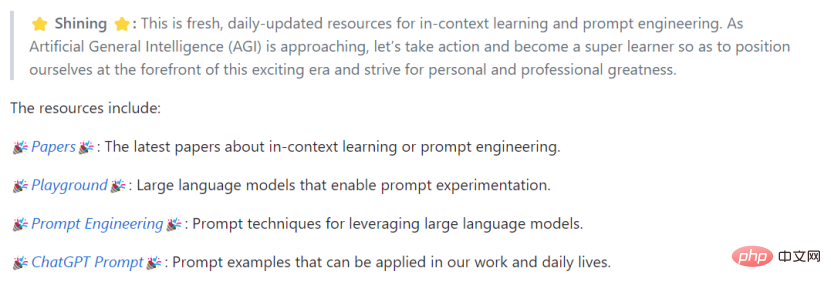
(1) Paper list
The list of papers is placed on the homepage. It mainly updates the content of papers involving prompt engineering review, basic large models, contextual learning, multi-modal prompts and other fields. The EgoAlpha community updates paper information daily and in the order of publication time. show.
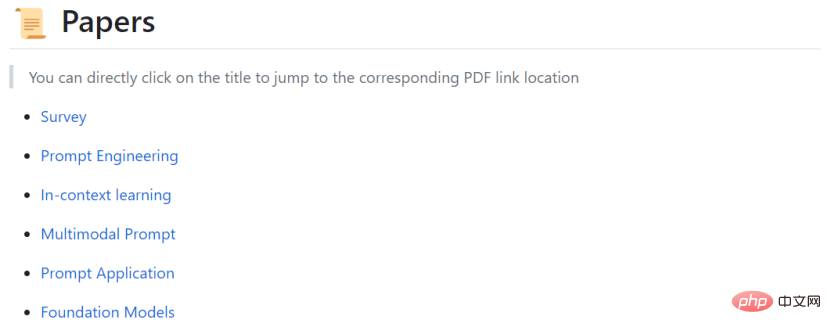
Each paper in this community provides: the publication time of the paper, the number of citations (Citations), the number of readings (Mendeley Readers), Number of relevant public reports, Github code hosting links, and community stars (Github Stars). The presentation of the above list facilitates readers to quickly locate high-value paper content for reading and learning. The following is an example of paper display:

Due to the limited page space, only up to 10 papers are presented in the fields covered by each paper. The complete list of papers can be clicked on each one. Jump directly to a more detailed page below the paper column. Click for an example:

(2) Model Testing Ground
#This column provides relevant information and network links of the current mainstream large models, readers can quickly access Use large models to practice and experience prompt learning.
At the same time, the EgoAlpha learning community tracks various large models and continuously supplements and updates relevant information of large models. Among them, the model testing site provides the latest and open source large models to facilitate readers' use and experience. The models in the table below can be accessed directly through the link. The direct page contains the usage guide and API interface of the model, which is convenient for all developers and researchers to explore and experience:
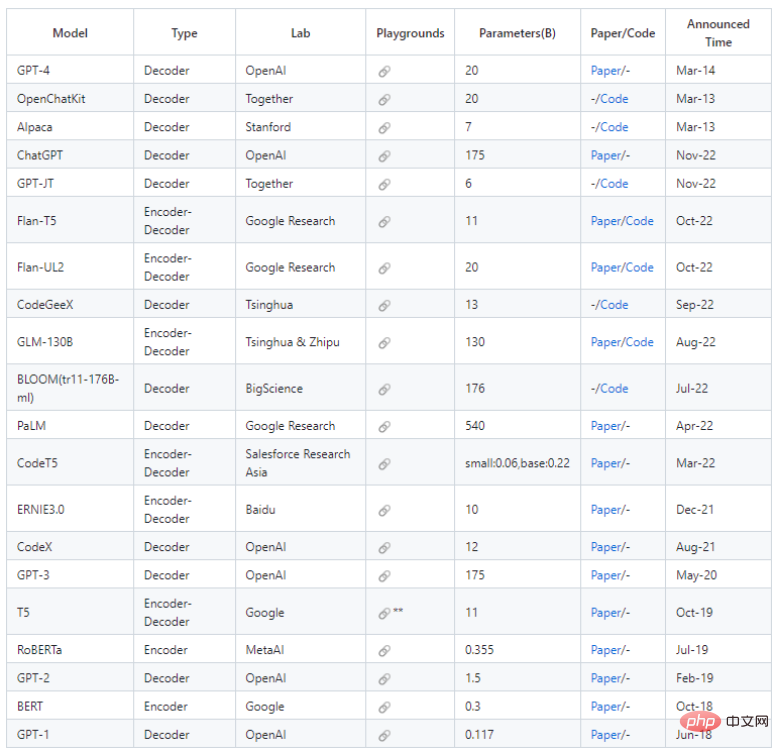
The models in the table below all provide pre-trained weights, developers can fine-tune them (without changing the original backbone architecture), and people can intuitively see it by using the pre-trained weights A working model for a good research team.
The following table shows that the relevant models and codes are not yet open source. However, instructions from the official website are provided to facilitate subsequent follow-up and update progress.
(3) Prompt Project
EgoAlpha releases tutorials on prompt projects, summarizing the latest research results at home and abroad , explains the methods and principles of the new generation of artificial intelligence technology, hoping to help readers start from scratch and gradually become proficient in related technologies and theories of prompt engineering and contextual learning.
This column provides general design principles and corresponding frameworks, and also provides general prompts and techniques to facilitate the use of prompt projects to generalize and handle more large model-related tasks.

(4) ChatGPT question examples
In Chinese and English The form is presented to the public and provides application examples of ChatGPT. From the three aspects of helping learning, helping work, and enriching experience, reasonable and interesting examples are used to show how to use ChatGPT to enhance personal abilities
This column is specially designed for ChatGPT and provides detailed Instructions for using the prompt project, including prompt design in many scenarios, facilitate readers to use efficient and flexible query methods to obtain the expected answer results.

We have written Chinese prompt project instructions for ChatGPT:
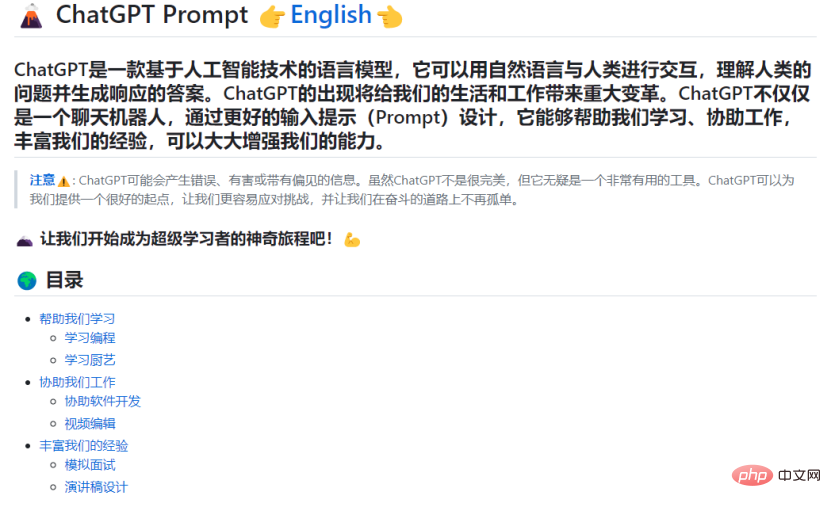
(5) Daily information
# Disseminate major domestic and foreign cutting-edge scientific and technological information every day, including updates to papers and the latest cutting-edge technology Dynamic, covering the research progress related to large models.
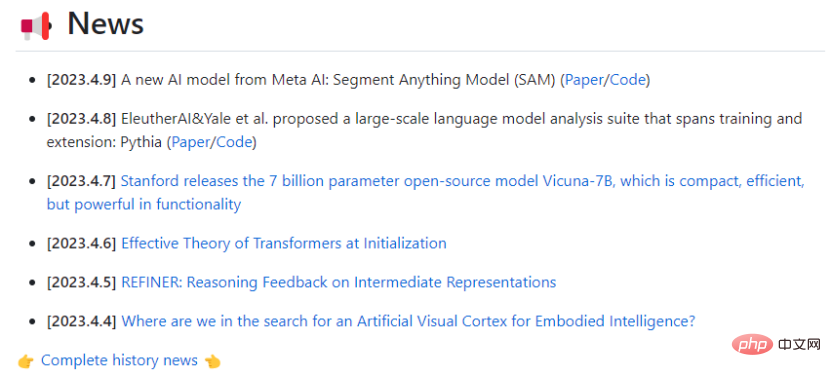
Follow-up improvement
Thesis section, this community will update and push papers in real time based on self-designed software programs; model The test site and prompt project will also add code cases in the future for developers to easily understand and use; the web page is also being developed in an orderly manner, aiming to present it to readers in a variety of ways, supplemented by more interactive methods, to bring more Good learning experience.
Community Focus
Research, learn and experience the latest technological achievements of general artificial intelligence (AGI). The development of general artificial intelligence will go through three important stages: perceptual intelligence, cognitive intelligence and evolutionary intelligence. Its development can be seen as a process from passive perception to active cognition and then to self-evolution. In this process, technology is rapidly iterating, and research results are overwhelming. EgoAlpha helps you grasp the latest cutting-edge trends in one stop, keep up with the times, and learn to use AI to help you improve your capabilities.
Welcome everyone to join the EgoAlpha learning community. If you have questions, there will be responses.
EgoAlpha is all you need!
The above is the detailed content of Proficient in large models such as ChatGPT and mastering the most cutting-edge technology, this is an excellent resource. For more information, please follow other related articles on the PHP Chinese website!

Hot AI Tools

Undresser.AI Undress
AI-powered app for creating realistic nude photos

AI Clothes Remover
Online AI tool for removing clothes from photos.

Undress AI Tool
Undress images for free

Clothoff.io
AI clothes remover

Video Face Swap
Swap faces in any video effortlessly with our completely free AI face swap tool!

Hot Article

Hot Tools

Notepad++7.3.1
Easy-to-use and free code editor

SublimeText3 Chinese version
Chinese version, very easy to use

Zend Studio 13.0.1
Powerful PHP integrated development environment

Dreamweaver CS6
Visual web development tools

SublimeText3 Mac version
God-level code editing software (SublimeText3)

Hot Topics
 WorldCoin (WLD) price forecast 2025-2031: Will WLD reach USD 4 by 2031?
Apr 21, 2025 pm 02:42 PM
WorldCoin (WLD) price forecast 2025-2031: Will WLD reach USD 4 by 2031?
Apr 21, 2025 pm 02:42 PM
WorldCoin (WLD) stands out in the cryptocurrency market with its unique biometric verification and privacy protection mechanisms, attracting the attention of many investors. WLD has performed outstandingly among altcoins with its innovative technologies, especially in combination with OpenAI artificial intelligence technology. But how will the digital assets behave in the next few years? Let's predict the future price of WLD together. The 2025 WLD price forecast is expected to achieve significant growth in WLD in 2025. Market analysis shows that the average WLD price may reach $1.31, with a maximum of $1.36. However, in a bear market, the price may fall to around $0.55. This growth expectation is mainly due to WorldCoin2.
 What does cross-chain transaction mean? What are the cross-chain transactions?
Apr 21, 2025 pm 11:39 PM
What does cross-chain transaction mean? What are the cross-chain transactions?
Apr 21, 2025 pm 11:39 PM
Exchanges that support cross-chain transactions: 1. Binance, 2. Uniswap, 3. SushiSwap, 4. Curve Finance, 5. Thorchain, 6. 1inch Exchange, 7. DLN Trade, these platforms support multi-chain asset transactions through various technologies.
 Why is the rise or fall of virtual currency prices? Why is the rise or fall of virtual currency prices?
Apr 21, 2025 am 08:57 AM
Why is the rise or fall of virtual currency prices? Why is the rise or fall of virtual currency prices?
Apr 21, 2025 am 08:57 AM
Factors of rising virtual currency prices include: 1. Increased market demand, 2. Decreased supply, 3. Stimulated positive news, 4. Optimistic market sentiment, 5. Macroeconomic environment; Decline factors include: 1. Decreased market demand, 2. Increased supply, 3. Strike of negative news, 4. Pessimistic market sentiment, 5. Macroeconomic environment.
 Aavenomics is a recommendation to modify the AAVE protocol token and introduce token repurchase, which has reached the quorum number of people.
Apr 21, 2025 pm 06:24 PM
Aavenomics is a recommendation to modify the AAVE protocol token and introduce token repurchase, which has reached the quorum number of people.
Apr 21, 2025 pm 06:24 PM
Aavenomics is a proposal to modify the AAVE protocol token and introduce token repos, which has implemented a quorum for AAVEDAO. Marc Zeller, founder of the AAVE Project Chain (ACI), announced this on X, noting that it marks a new era for the agreement. Marc Zeller, founder of the AAVE Chain Initiative (ACI), announced on X that the Aavenomics proposal includes modifying the AAVE protocol token and introducing token repos, has achieved a quorum for AAVEDAO. According to Zeller, this marks a new era for the agreement. AaveDao members voted overwhelmingly to support the proposal, which was 100 per week on Wednesday
 How to win KERNEL airdrop rewards on Binance Full process strategy
Apr 21, 2025 pm 01:03 PM
How to win KERNEL airdrop rewards on Binance Full process strategy
Apr 21, 2025 pm 01:03 PM
In the bustling world of cryptocurrencies, new opportunities always emerge. At present, KernelDAO (KERNEL) airdrop activity is attracting much attention and attracting the attention of many investors. So, what is the origin of this project? What benefits can BNB Holder get from it? Don't worry, the following will reveal it one by one for you.
 What are the hybrid blockchain trading platforms?
Apr 21, 2025 pm 11:36 PM
What are the hybrid blockchain trading platforms?
Apr 21, 2025 pm 11:36 PM
Suggestions for choosing a cryptocurrency exchange: 1. For liquidity requirements, priority is Binance, Gate.io or OKX, because of its order depth and strong volatility resistance. 2. Compliance and security, Coinbase, Kraken and Gemini have strict regulatory endorsement. 3. Innovative functions, KuCoin's soft staking and Bybit's derivative design are suitable for advanced users.
 The top ten free platform recommendations for real-time data on currency circle markets are released
Apr 22, 2025 am 08:12 AM
The top ten free platform recommendations for real-time data on currency circle markets are released
Apr 22, 2025 am 08:12 AM
Cryptocurrency data platforms suitable for beginners include CoinMarketCap and non-small trumpet. 1. CoinMarketCap provides global real-time price, market value, and trading volume rankings for novice and basic analysis needs. 2. The non-small quotation provides a Chinese-friendly interface, suitable for Chinese users to quickly screen low-risk potential projects.
 Rexas Finance (RXS) can surpass Solana (Sol), Cardano (ADA), XRP and Dogecoin (Doge) in 2025
Apr 21, 2025 pm 02:30 PM
Rexas Finance (RXS) can surpass Solana (Sol), Cardano (ADA), XRP and Dogecoin (Doge) in 2025
Apr 21, 2025 pm 02:30 PM
In the volatile cryptocurrency market, investors are looking for alternatives that go beyond popular currencies. Although well-known cryptocurrencies such as Solana (SOL), Cardano (ADA), XRP and Dogecoin (DOGE) also face challenges such as market sentiment, regulatory uncertainty and scalability. However, a new emerging project, RexasFinance (RXS), is emerging. It does not rely on celebrity effects or hype, but focuses on combining real-world assets (RWA) with blockchain technology to provide investors with an innovative way to invest. This strategy makes it hoped to be one of the most successful projects of 2025. RexasFi





